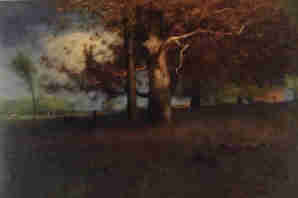
"Early Autumn, Montclair"
INNESS ART
(ORIGINALLY PUBLISHED: 1978 IN THE SANTA
BARBARA NEWS AND REVIEW)
By Dan Gheno
GEORGE INNESS was a frail man who was often subject to epileptic attacks. Yet Inness produced one of the largest oeuvres of any 19th century American landscape artist.
Inscribed behind one of his last paintings—"Morning, Catskills Valley" --- is the number 1405. It is but one of many 1arge scale, emotionally charged paintings that lnness fanatically produced in the last years of his life.
The current exhibition at the Santa Barbara Museum of Art, GEORGE INNESS, LANDSCAPES: HIS SIGNATURE YEARS 1884-1894 (from the Oakland Art Museum) leaves no doubt about the stature of his work in his "declining years." As we walk in the large gallery at the Museum of Art, we are immediately struck by the massive strength that glows from his naturalistic studies. What nature declined him personally, he found vicariously in the landscapes.
Inness professed that his purpose as a landscape artist was "not to imitate a fixed material condition, but to represent a living motion."
"Early Autumn, Montclair" portrays centuries of growth in a large ponderous tree. From a bulky base, spindly branches reach out defiantly. They seem. racked and amputated by violent storms, but they move In a determined if erratic path.
In the dark terrain below, the look and smell of countless seasons and fallen leaves is pungently depicted by the artist’s golden palette bearing silent witness to nature’s never ending cycles.
Integrity of Man in Nature
A Follower of the mystic Emanuel Swedenborg, George Inness always felt an almost religious empathy for the Earth.
The artist often stated he was not out to glorify nature, but to express Its hidden spirit and underlying character.’’
Inness sought and researched nature all over the globe, traveling from his base in New York. Always, however, he returned to the seclusion:, of his studio to record his observations.
" In his studio, he was like a madman" his son reminisces in his biography. ‘With a sudden Inspiration, he would go at a canvas with the most dynamic energy, creating the composition from his own brain, but with so thorough an underlying knowledge of nature that the keynote of his landscapes was always truth and sincerity and absolute fidelity to nature."
It was this physical distance from nature that possibly saved him from the excesses of his melodramatic contemporaries in the Hudson River School. Even the most restrained artists, like Frederic Church, often treated nature with a maniacal deference and respect nearly bordering on chauvinism.
They rendered Earth an imperious, pompous entity where humans are rarely seen, with rainbows and sun rays romantically beaming down from the sky like lifelines to heaven.
Inness termed his work "civilized landscapes" and tried to implement Swedenborgs view that humankind was integral to nature’s spirit and processes. The artist’s figures, painted with abbreviated brushstrokes into the landscape, are like vertical kindred to the timber, visually melting into the topography almost unnoticed.
As In "Autumn Woodlands," a fog or heavy shadow will frequently blur the artist’s subjects, figures and landscape into an even more homogenous whole. But always—despite the pervasive atmosphere—the anatomy of his landscape is structurally sound. The trees seem to hold up the sky for the humans in "The Old Farm Montclair," the wooden sentries standing a patient vigil over their cattle and fragile structures. One big, happy family.
Landscape Death Masks
Yet over the horizon, trouble brews. In Inness’ realm, clouds are usually on the verge of downpour, or dusk is approaching. The sun never seems to rise, only set. Something invariably seems to be looming from beyond that chunk of blue sky—something ominous.
Indeed, many of lnness’ paintings read like death masks of majestic landscapes—Newark, Hackensack, the Hudson river—replaced by modern industries or concrete.
It’s sobering and ironic to view these brittle and delicate canvases and gaze at the only remnants of the strong and hefty trees that once dotted Inness’ favorite creative waterholes. We’re led to doubt Theodore Rousseau's quote, cited by Alfred Werner in lnness’ Landscapes, that "trees were images of permanence and great history which would never change."
And yet, Inness would probably agree with the Indians that the Eastern Seaboard is not yet lost, that "Mother Nature" will reclaim her dominion. Inness shows the towering, lumbering mountains precariously embracing our flimsy buildings with the delicacy of an elephant’s foot, gently poised over our heads. These mountains could just as easily crush us as cradle us, and the sumptuous trees, awash with impenetrable foliage, could suffocate us with like ease
As an ally and participant to nature, lnness stated: "Eden was; it will not be again. We must work our way to Paradise."
| REVIEW #7 | REVIEW #8 | REVIEW #9 | REVIEW # 10 | |
| REVIEW #12 | REVIEW #13 | REVIEW #14 | REVIEW #15 | |